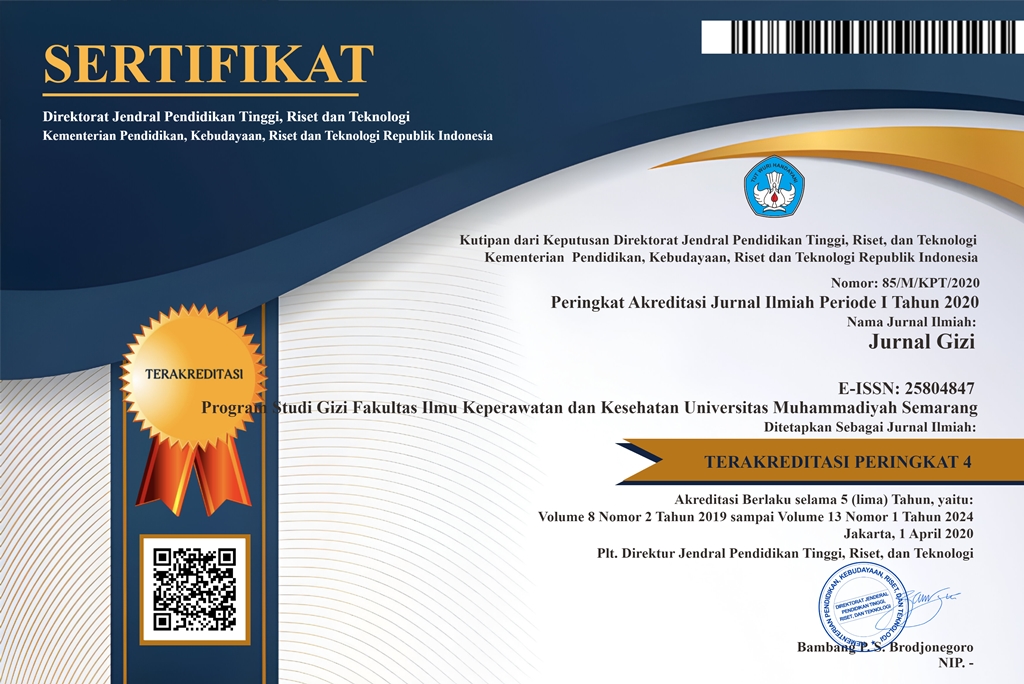Perbedaan Produktivitas Kerja Pekerja Wanita Berdasarkan Tingkat Konsumsi Energi, Protein dan Zat Besi di CV. Mubarokfood Cipta Delicia
(1)
(2)
(3)
(*) Corresponding Author
Abstract
The women participation in economic activities are not a new phenomenon in Indonesia. The number of women workers are getting higher every year. But the nutrition and health of
women worker have not received the good attention, so it can lead to women worker productivity is lower than in male workers.
One of the factors that affect the productivity of labor is the adequacy of nutrients, such as: energy, protein, fat, and carbohydrate, where are as macro nutrients the body needs. In
addition to the adequacy of macro nutrients, micronutrients also play an important role in the body. One of them is iron, iron consumption is inadequate will increase the absorption of iron
from food, mobilizing iron stores in the body, reducing the transportation of iron to the bone marrow, and a decrease in hemoglobin, resulting in anemia and ultimately can reduce the
productivity of labor of women.
The research is analytic research was done at CV. Mubarok Food Cipta Delicia, thats have 25 people as women workers. All of the women workers were used as the sample in this study. Analysis of the data using One Way Anova Test.
The results showed that the average energy consumption of women workers is 1747.2 kcal and fulfilling 79,5 % of the daily energy requirement. The average consumption of protein
women workers is 53.4 grams and fulfilling 91.5% of the daily protein requirement. While the average consumption of women worker iron are 8.9 mg and fulfilling 39.5% of the daily iron
requirement. Test results show there are no difference in labor productivity of women employe based on their level of energy consumption (p= 0,57), protein(p =0,483) and iron (p = 0,153).
Key words: women worker productivity, energy consumption, protein consumption, iron consumsption.
women worker have not received the good attention, so it can lead to women worker productivity is lower than in male workers.
One of the factors that affect the productivity of labor is the adequacy of nutrients, such as: energy, protein, fat, and carbohydrate, where are as macro nutrients the body needs. In
addition to the adequacy of macro nutrients, micronutrients also play an important role in the body. One of them is iron, iron consumption is inadequate will increase the absorption of iron
from food, mobilizing iron stores in the body, reducing the transportation of iron to the bone marrow, and a decrease in hemoglobin, resulting in anemia and ultimately can reduce the
productivity of labor of women.
The research is analytic research was done at CV. Mubarok Food Cipta Delicia, thats have 25 people as women workers. All of the women workers were used as the sample in this study. Analysis of the data using One Way Anova Test.
The results showed that the average energy consumption of women workers is 1747.2 kcal and fulfilling 79,5 % of the daily energy requirement. The average consumption of protein
women workers is 53.4 grams and fulfilling 91.5% of the daily protein requirement. While the average consumption of women worker iron are 8.9 mg and fulfilling 39.5% of the daily iron
requirement. Test results show there are no difference in labor productivity of women employe based on their level of energy consumption (p= 0,57), protein(p =0,483) and iron (p = 0,153).
Key words: women worker productivity, energy consumption, protein consumption, iron consumsption.
Full Text:
PDFArticle Metrics
Abstract view : 578 timesPDF - 64 times
DOI: https://doi.org/10.26714/jg.5.2.2016.%25p
Refbacks
- There are currently no refbacks.
Diterbitkan oleh: Program Studi Gizi (D3 dan S1)
Fakultas Ilmu Keperawatan dan Kesehatan
Universitas Muhammadiyah Semarang
Sekretariat: Jl. Kedungmundu Raya No. 18 Semarang
Contact Person : Hapsari Sulistya Kusuma, S.Gz, M.Si (+62 85 6 41 536 553)

This work is licensed under a Creative Commons Attribution 4.0 International License.









.png)
.png)